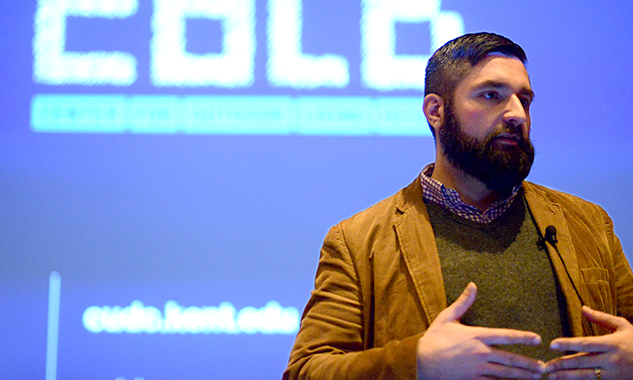Lecturer aspires to find design solutions for cold cities
David Jurca, Kent State architecture faculty member presents a lecture about design competition in cold enviornments in the Schwartz Center on Wendesday, Mar. 5, 2014.
March 6, 2014
The associate director of the Cleveland Urban Design Collaborative, or CUDC, urged designers to confront the challenges cold temperatures pose for shrinking cities, such as Cleveland, with practical solutions, at a presentation Wednesday night.
“We’re looking increasingly at this idea of responsive design involving how a built environment can respond quickly to become flexible to changing weather conditions and the potential design implications for climate change issues as well,” associate director David Jurca said.
Jurcas’s lecture served as the second in the College of Architecture and Environmental Design’s spring 2014 “Celebrate CAED” lecture series. He spoke to a small crowd of architecture students in the Schwartz Center auditorium.
“It is important to highlight the efforts of our faculty and various members of the college who are doing interesting things,” said Bill Willoughby, associate professor of the College of Architecture and Environmental Design, on the purpose of the “Celebrate CAED” lecture series.
The subject of Jurca’s lecture was the Cleveland Urban Design Collaborative, the home of Kent State’s urban design graduate program and the public service activities of the College of Architecture and Environmental Design, and the launching of its new COLD initiative, which appropriately stands for the Center for Outdoor Living Design.
“What we like to do at the CUDC is think about aspects of culture that may be perceived as liabilities and, using design judo, turn them into assets,” Jurca said.
COLD aims to encourage designers to creatively engage the challenges cold weather poses upon urban centers. The COLD initiative’s inaugural year consisted of a design competition, an online archive of competition submissions, an outdoor exhibit of winning designs in downtown Cleveland and the publication of “COLDSCAPES,” the sixth volume in the CUDC’s “Urban Infill” journal series, Jurca said.
One of the winning competition designs, “Second Hinterlands,” submitted by Chicago-based designers Noel Turgeon and Natalya Egon, involved snowscaping, or designing with snow as a workable medium, Jurca said.
Jurca asked the audience if any of the students had previously incorporated the winter seasons into their renderings for class. He said it is important to keep winter’s impact in mind while designing so creative approaches for urban livability in the cold are not left unexplored.
“It’s definitely something to consider when dealing with winter weather cities,” said Kaycee Lowengrub, a junior architecture major. “It’s true – you don’t inhabit outdoor areas and you waste a lot of the city space because you’re just huddled in your house.”
Junior architecture major Cayla Walter also said the presentation will make her rethink incorporating weather into her future designs.
“I think this lecture will help me think about climates more and how to implement that concept into my renderings,” said Walter.
Associate professor Diane Davis-Sikora will present the third lecture in the “Celebrate CAED” series on April 23 about her film, “Structures of Air.” The lecture will take place at 7 p.m. in the Schwartz Center auditorium room 177.
For additional information about the Center for Outdoor Living Design, visit http://www.cudc.kent.edu/cold/.
Contact Justin Sheil at [email protected].

























